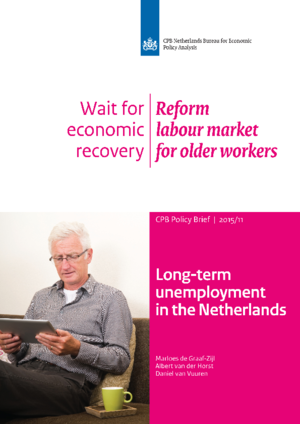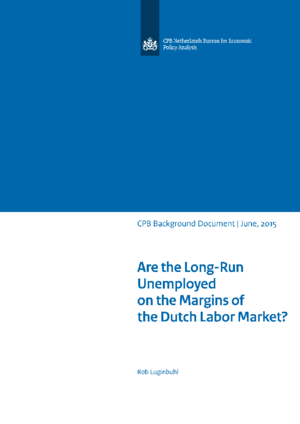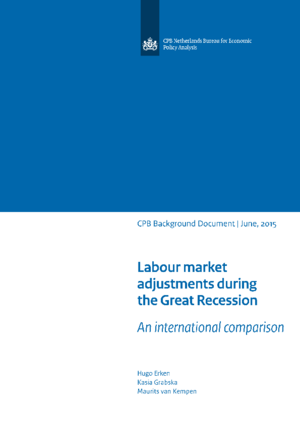Long-term unemployment in the Netherlands
Older people often in long-term unemployment
This is the conclusion by CPB researchers Marloes de Graaf-Zijl, Albert van der Horst and Daniel van Vuuren in the CPB Policy Brief ’Long-term unemployment in the Netherlands’. This policy brief will be presented today during the annual CPB Lecture which, this year, will be delivered by Princeton economist Alan B. Krueger.
As the economy recovers, long-term unemployment will decrease, even without government intervention. Currently this involves a group of 270,000 people who have been without employment for more than one year. After previous recessions, long-term unemployment dropped to around 1% of the labour force. This is also a realistic prospect, this time round. Long-term unemployment in the Netherlands is currently relatively high as a result of a slower economic recovery than in other countries.
Nearly half of all the long-term unemployed people are over the age of 50. This is not because older employees lose their job more often, but because once they do become unemployed, their chances of remaining in this situation for the long term are almost twice as high, compared to the average.
The problem of older unemployed people dates back to the period before the Great Recession, when people were required to continue working for longer. But the labour market has not been properly adjusted to accommodate the entire group of older workers.
Policies by government and social partners award older employees more rights and make them more expensive. This makes prospective employers hesitant to hire older workers. Policies aimed to address this problem have to date appeared insufficiently effective. More fundamental reform is necessary, such as unemployment benefits that decrease over time, employment protection that is less dependent on the length of the labour contract, and a reduction in the age-dependent arrangements in collective labour agreements.
Downloads
In the aftermath of the Great Recession, the Netherlands is faced with 270,000 people who have been unemployed for more than one year, representing over 3% of the labour force. In this respect, the Netherlands is doing worse than Germany, the United States and the Nordic countries. Long-term unemployment negatively affects people’s happiness as well as their employability. Moreover, for the government it also means a decline in tax revenue and an increase in social security expenditure.
As the economy recovers, long-term unemployment will go down, even without government intervention. Following earlier recessions, the decline has been around 1% and this is currently also a realistic prospect. The current relatively high level of long-term unemployment in the Netherlands is the result of a slower economic recovery than in other countries. Wage developments and the alleged inflexibility of the Dutch labour market also play a role, but to a lesser degree.
Nevertheless, certain short-term measures may help to reduce long-term unemployment. A temporary measure that could be effective is to provide unemployed people with a financial bonus when they manage to find and hold on to a job. Retraining may help people who used to work in one of the few shrinking sectors and who are therefore unable to return to their former profession.
The current long-term unemployment has however brought a persistent problem to light, namely that of the labour market for older people. More than 40% of the long-term unemployed are over the age of fifty. Older employees do not lose their job more often than others, but once they do become unemployed, their chances of ending up in long-term unemployment are nearly double the average. Employers hesitate to hire older unemployed people because these often demand a higher wage than the employers are willing to pay.
The high share of older people among the long-term unemployment is a structural problem rather than a cyclical one. Before the start of the crisis, this level was already on the rise. The current package of policy measures – largely aimed at lower wage costs – is insufficient to help the older unemployed to find another job. More fundamental reforms– such as unemployment benefits that decrease with the duration of unemployment, employment protection that is less dependent on the length of the labour contract, and less age-dependent arrangements in collective labour agreements – are necessary to permanently improve the position of the older unemployed.
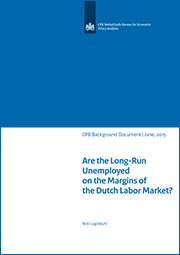
This is reflected in recent studies demonstrating that the long-run unemployed become divorced from the labor market.
In this study we examine the question of whether either the long-run unemployed or discouraged workers in The Netherlands exert influence on the labor market. We reproduce the study of Kruger et al. (2014) in which the authors address this question for the US. In particular, in their final conference draft, Krueger et. al. obtain estimates for the Phillips and Beveridge Curves specified as functions of both the short-run and long-run unemployment rates. They find the expected negative relationships for short-run unemployment with wages, inflation, and vacancies, but no significant relationships for the long-run rate. Our estimates for The Netherlands corroborate these findings. We extend their study by also looking for a possible effect of the discourage worker rate on wages, inflation and vacancies, but are unable to find any significant effects. Our results therefore suggest that neither the long-run unemployed nor discouraged workers exert any significant influence on aggregate labor market outcomes. In particular, we obtain our clearest results with wages based on the real wage Phillips Curve.
In Kruger et al. (2014) the authors work with the short-run unemployment rate defined as the rate for those unemployed for less than a half year. The Dutch data enables us to investigate the sensitivity to this arbitrary cutoff, as it allows us to determine short-run unemployment rates for durations of less than a half, one, two and three years. In same manner our long-run measures of the unemployment rate consist of durations of greater than a half, one, two, and three years. The pattern of our results is robust to the various short-run and long-run measures of unemployment we use. As a further check of robustness we also obtain estimates based on our original quarterly data aggregated to annual series.
We estimate a price Phillips Curve, a real wage Phillips Curve, and the Beveridge Curve. The results from the real wage Phillips Curve and Beveridge Curve produce the clearest indication that only short-run unemployment is relevant in the estimated relationships. We discuss the real wage Phillips Curve estimates in section 3. The presentation of the Beveridge Curve estimates follows in section 4. Thereafter we present the estimates for the price Phillips Curve in section 5 and draw some conclusions in the final section 6. In the next section we first begin with a discussion of the models.
Downloads
Authors

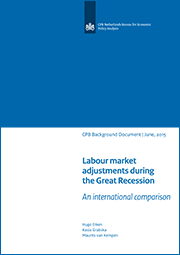
It matters whether cumulated loss of gross domestic product (GDP) in most recent crisis is roughly 3%, as was the case in the United States, or cumulatively almost 30%, as was the case in Greece. Second, the adjustment process in the economy is also driven by the institutional setting. This paper provides some background with the analysis presented in Chapter 3 of the Policy Brief ‘Langdurige werkloosheid: afwachten én hervormen’.
The main question we address in this document is: what was the impact of recent financial crisis on wages, unemployment and profits within different economies? In other words: who paid the price of the Great Recession?
In order to provide an answer, we look at the development of the main components of GDP (compensation of employees and operating surplus). To address the impact of adjustments on the labour market, we perform a further decomposition of changes in the compensation of employees into changes of real wages, unemployment, hours worked, and participation. Note that this method is mainly based on accounting rules and that it does not account for the underlying economic and institutional structures which differ between economies.
We conclude that the Great Recession was almost immediately reflected in a drop in the profits in most countries. In a similar way, profits increased immediately during the recovery from the crisis. In most economies, labour market adjustments occur with some delay. Regarding these adjustments economies differ in their responses in real wage rate and long-term unemployment during the Great Recession. This leads to three categories of countries. The Netherlands belongs to a group of countries with a limited change in the real wage and a relatively limited increase in long-term unemployment. A second group, containing, for instance, the UK and US shows a relatively large downward adjustment in the real wages and a relatively small increase in long-term unemployment; while the third group, including for instance Spain and Italy, shows a relatively large increase in long-term unemployment combined with an increase in real wages.
In the next section, we describe the theoretical perspective, as well as empirical literature, on adjustment mechanisms on the labour market in response to a drop in aggregate demand. Section 3 explains the decomposition methodology of changes in GDP and the data we use to conduct our empirical analysis. In Section 4 we present the result of the empirical analysis for a group of OECD countries.
